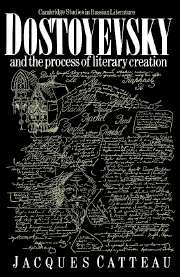Book contents
- Frontmatter
- Contents
- Preface to the English edition
- List of abbreviations
- General editor's note on transliteration and references
- General introduction
- PART I The creative environment
- PART II The process of creation
- Part III Time and space in the world of the novels
- Introduction
- 19 The master of men and hours
- 20 Chronology and temporality in The Idiot
- 21 The ascending spiral
- 22 Time of power and power of time
- 23 The havens of eternity
- 24 The dream of space and the space of the real
- 25 The inventory and the expressionist orchestration of scenery and lighting
- 26 The semantics of colour
- 27 The hero in space: sighting and seeing
- Conclusion
- Notes
- Select bibliography
- Index of names
27 - The hero in space: sighting and seeing
Published online by Cambridge University Press: 18 December 2009
- Frontmatter
- Contents
- Preface to the English edition
- List of abbreviations
- General editor's note on transliteration and references
- General introduction
- PART I The creative environment
- PART II The process of creation
- Part III Time and space in the world of the novels
- Introduction
- 19 The master of men and hours
- 20 Chronology and temporality in The Idiot
- 21 The ascending spiral
- 22 Time of power and power of time
- 23 The havens of eternity
- 24 The dream of space and the space of the real
- 25 The inventory and the expressionist orchestration of scenery and lighting
- 26 The semantics of colour
- 27 The hero in space: sighting and seeing
- Conclusion
- Notes
- Select bibliography
- Index of names
Summary
It is not surprising that Stendhal never tells us the colour of Fabrice's eyes: they are eyes which see, not eyes which are seen.
G. Blin, Stendhal et les problèmes du romanMovement and look
The setting orchestrated by Dostoyevsky is devoid of ornament but rich in a convergence of signs which anticipate ideas and actions. Lines, volume, lighting and colours are given dramatic, psychological and even philosophical parts, for the scenery reveals the intention of the novelist, master of destinies. Like the sign of fire which appeared to the king of Babylon, it is a tragic sign which cannot be interpreted when it appears, but which stresses the impression of fatality by appearing again and again: the messages of the gods, written in space.
But space is also the natural medium existing a priori, in which the characters of the novel move. Considered from this viewpoint, it is closely dependent on the movement and look of the hero, who has two attitudes in space: either he acts in it or he looks at it. In the first case, space is crossed; it is not described or even inventoried, it is simply marked out with references which trace movement. It is a route, a topography of the action. Space is not seen but perceived; it is sighted. In the second case, there is a landscape, space is contemplated by the hero who invests it with his own attributes, and it is then seen. These two attitudes recall the two aspects of time; sighting corresponds to the time of power, when freedom is painfully exercised: seeing is chronicle time, the time of distrustful elucidation.
- Type
- Chapter
- Information
- Dostoyevsky and the Process of Literary Creation , pp. 412 - 443Publisher: Cambridge University PressPrint publication year: 1989



